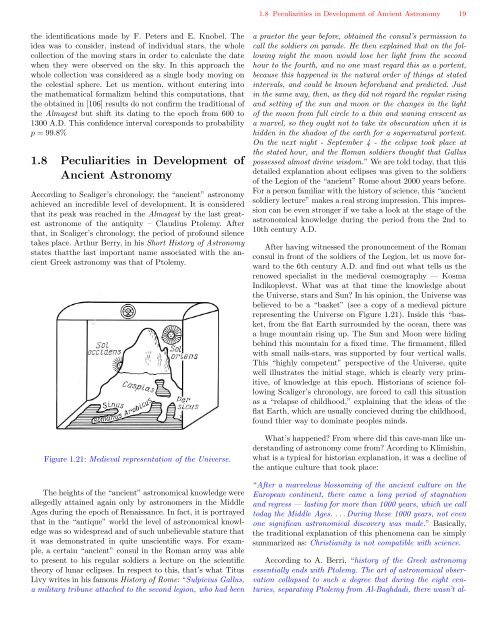mysteries of egyptian zodiacs - HiddenMysteries Information Central
mysteries of egyptian zodiacs - HiddenMysteries Information Central
mysteries of egyptian zodiacs - HiddenMysteries Information Central
You also want an ePaper? Increase the reach of your titles
YUMPU automatically turns print PDFs into web optimized ePapers that Google loves.
the identifications made by F. Peters and E. Knobel. The<br />
idea was to consider, instead <strong>of</strong> individual stars, the whole<br />
collection <strong>of</strong> the moving stars in order to calculate the date<br />
when they were observed on the sky. In this approach the<br />
whole collection was considered as a single body moving on<br />
the celestial sphere. Let us mention, without entering into<br />
the mathematical formalizm behind this computations, that<br />
the obtained in [106] results do not confirm the traditional <strong>of</strong><br />
the Almagest but shift its dating to the epoch from 600 to<br />
1300 A.D. This confidence interval coresponds to probability<br />
p = 99.8%<br />
1.8 Peculiarities in Development <strong>of</strong><br />
Ancient Astronomy<br />
According to Scaliger’s chronology, the “ancient” astronomy<br />
achieved an incredible level <strong>of</strong> development. It is considered<br />
that its peak was reached in the Almagest by the last greatest<br />
astronome <strong>of</strong> the antiquity – Claudius Ptolemy. After<br />
that, in Scaliger’s chronology, the period <strong>of</strong> pr<strong>of</strong>ound silence<br />
takes place. Arthur Berry, in his Short History <strong>of</strong> Astronomy<br />
states thatthe last important name associated with the ancient<br />
Greek astronomy was that <strong>of</strong> Ptolemy.<br />
Figure 1.21: Medieval representation <strong>of</strong> the Universe.<br />
The heights <strong>of</strong> the “ancient” astronomical knowledge were<br />
allegedly attained again only by astronomers in the Middle<br />
Ages during the epoch <strong>of</strong> Renaissance. In fact, it is portrayed<br />
that in the “antique” world the level <strong>of</strong> astronomical knowledge<br />
was so widespread and <strong>of</strong> such unbelievable stature that<br />
it was demonstrated in quite unscientific ways. For example,<br />
a certain “ancient” consul in the Roman army was able<br />
to present to his regular soldiers a lecture on the scientific<br />
theory <strong>of</strong> lunar eclipses. In respect to this, that’s what Titus<br />
Livy writes in his famous History <strong>of</strong> Rome: “Sulpicius Gallus,<br />
a military tribune attached to the second legion, who had been<br />
1.8 Peculiarities in Development <strong>of</strong> Ancient Astronomy 19<br />
a praetor the year before, obtained the consul’s permission to<br />
call the soldiers on parade. He then explained that on the following<br />
night the moon would lose her light from the second<br />
hour to the fourth, and no one must regard this as a portent,<br />
because this happened in the natural order <strong>of</strong> things at stated<br />
intervals, and could be known beforehand and predicted. Just<br />
in the same way, then, as they did not regard the regular rising<br />
and setting <strong>of</strong> the sun and moon or the changes in the light<br />
<strong>of</strong> the moon from full circle to a thin and waning crescent as<br />
a marvel, so they ought not to take its obscuration when it is<br />
hidden in the shadow <strong>of</strong> the earth for a supernatural portent.<br />
On the next night - September 4 - the eclipse took place at<br />
the stated hour, and the Roman soldiers thought that Gallus<br />
possessed almost divine wisdom.” We are told today, that this<br />
detailed explanation about eclipses was given to the soldiers<br />
<strong>of</strong> the Legion <strong>of</strong> the “ancient” Rome about 2000 years before.<br />
For a person familiar with the history <strong>of</strong> science, this “ancient<br />
soldiery lecture” makes a real strong impression. This impression<br />
can be even stronger if we take a look at the stage <strong>of</strong> the<br />
astronomical knowledge during the period from the 2nd to<br />
10th century A.D.<br />
After having witnessed the pronouncement <strong>of</strong> the Roman<br />
consul in front <strong>of</strong> the soldiers <strong>of</strong> the Legion, let us move forward<br />
to the 6th century A.D. and find out what tells us the<br />
renowed specialist in the medieval cosmography — Kosma<br />
Indikoplevst. What was at that time the knowledge about<br />
the Universe, stars and Sun? In his opinion, the Universe was<br />
believed to be a “basket” (see a copy <strong>of</strong> a medieval picture<br />
representing the Universe on Figure 1.21). Inside this “basket,<br />
from the flat Earth surrounded by the ocean, there was<br />
a huge mountain rising up. The Sun and Moon were hiding<br />
behind this mountain for a fixed time. The firmament, filled<br />
with small nails-stars, was supported by four vertical walls.<br />
This “highly competent” perspective <strong>of</strong> the Universe, quite<br />
well illustrates the initial stage, which is clearly very primitive,<br />
<strong>of</strong> knowledge at this epoch. Historians <strong>of</strong> science following<br />
Scaliger’s chronology, are forced to call this situation<br />
as a “relapse <strong>of</strong> childhood,” explaining that the ideas <strong>of</strong> the<br />
flat Earth, which are usually concieved during the childhood,<br />
found thier way to dominate peoples minds.<br />
What’s happened? From where did this cave-man like understanding<br />
<strong>of</strong> astronomy come from? Acording to Klimishin,<br />
what is a typical for historian explanation, it was a decline <strong>of</strong><br />
the antique culture that took place:<br />
“After a marvelous blossoming <strong>of</strong> the ancient culture on the<br />
European continent, there came a long period <strong>of</strong> stagnation<br />
and regress — lasting for more than 1000 years, which we call<br />
today the Middle Ages. . . . During these 1000 years, not even<br />
one significan astronomical discovery was made.” Basically,<br />
the traditional explanation <strong>of</strong> this phenomena can be simply<br />
summarized as: Christianity is not compatible with science.<br />
According to A. Berri, “history <strong>of</strong> the Greek astronomy<br />
essentially ends with Ptolemy. The art <strong>of</strong> astronomical observation<br />
collapsed to such a degree that during the eight centuries,<br />
separating Ptolemy from Al-Baghdadi, there wasn’t al-



